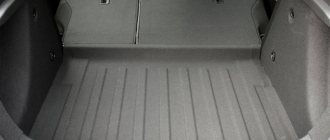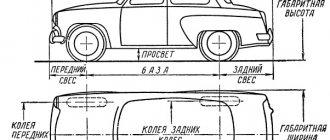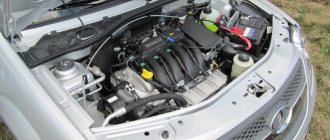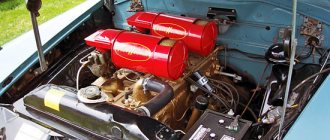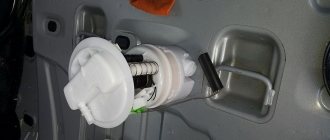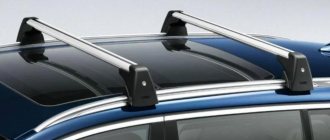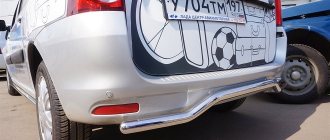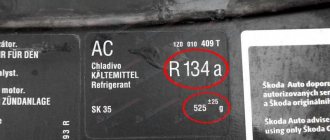Hi all! As you may have guessed, today we are talking about the Lada Larus and the trunk volume of this domestic car.
Surely you know that Largus is essentially a version of another car adapted to Russian conditions. We are talking about the Dacia Logan MCV. This is the same Renault Logan, only under the brand of a Romanian company.
The car turned out to be practical and inexpensive. You shouldn't expect incredible speeds and high power here. This is a budget workhorse that attracts with its value and versatility.
Trunk volume Lada Largus
The trunk of the Lada Largus (7 seats) is only 135 liters; folding the third row of seats increases the volume to 560 liters.
The same trunk volume of a 5-seater station wagon. The maximum capacity of the luggage compartment is achieved when all rows of seats are folded, then the volume increases to 2350 liters.
The trunk of the Lada Largus van is more spacious and amounts to 2540 liters.
"Insides" of the car
The Lada-Largus van is equipped with the same gasoline engines as the station wagon of the same name - these are in-line fours with a displacement of 1.6 liters:
- 8-valve engine that is capable of developing 87 hp. With. at 5100 rpm.
- 16-valve engine with a potential of 106 hp. With. at 5800 rpm.
As standard, the car is equipped with a 5-speed manual transmission and a front-wheel drive transmission. From 0 to 100 km/h the Lada-Largus van picks up speed in 14-15.4 seconds to 158-165 km/h. In the combined cycle, the car “eats” 7.9-8.2 liters of fuel for every hundred kilometers.
The van is built on the front-wheel drive B0 platform. The actual size of the body of the Lada-Largus van and the dimensions of the entire structure make the car practical and at the same time visually compact.
Internal dimensions of the cabin (luggage compartment)
The trunk volume of the Largus Station wagon directly depends on the number of installed rows of seats. In liters it will be accordingly: 135/560/2350
Load capacity may vary slightly depending on modification. Average - about 550 kg . (more precisely in the characteristics)
Dimensions of the cabin and luggage compartment (for transportation of long cargo)
The length of the cabin from the trunk door to the windshield in the area of the dashboard is 3 m. 14 cm . Distance from tailgate to dashboard
2 m. 70 cm . The diagonal size of the cabin (from corner to corner) is 3 m. 24 cm . The width of the cabin behind the front seats is 1 m 43 cm. The width of the cabin at the shoulder level of the third row passengers is about 1 m 29 cm . Distance from the tailgate threshold to the folded rear seat of the second row (it stands upright)
1.5 m (max 1.66 m) With the rear seat completely removed, the distance will increase by another 20 cm .
To transport long items, fold down the backrest of the second row and recline the backrest of the front passenger seat onto it. An extra-long weight can be rested with one end on the instrument panel, just be sure to place something soft so as not to scratch the plastic. And secure the length with a seat belt.
L1 - 910-1120mm, L2 - 590-790mm, H - 1310mm, H1 - 1080mm, H2 - 1020mm, B1 - 1380mm, B2 - 1405mm, L3 min/max - 1250/1700mm, B3 min - 1000mm, H3 - 475/ 1050mm, H4 - 920mm, Vbag . - 488 l.
Approximate internal dimensions of the luggage compartment Largus Station wagon
Internal dimensions of Largus Van
The internal volume of the serial Largus van is 2.54 m³.
Dimensions of the trunk door opening: height 92 cm, width 96 cm. Diagonal from the top corner to the wheel arch: 128 cm. Internal distance between the wheel arches 96 cm. Distance from the edge of the trunk to the partition: 194 cm.
Dimensions of doorways, trunk, hood, etc.
Video
Car interior: there is always space
The design choice of the design of the interior space of the car is considered quite successful for the following reasons:
- The driver's seat is separated from the cargo compartment, which allows you to transport various types of cargo, such as household cosmetics, food, building materials, fabrics, etc.;
- cargo compartment volume - more than 2.5 cubic meters. m.; actual dimensions of the trunk of the Lada-Largus van: length - 187 cm; opening width - 108 cm; in the area of the wheel arches - 98 cm; the width behind the wheel arches is 134 cm; height - 92 cm.
The driver is equipped with the most comfortable cabin for driving in literally any conditions, however, the interior can only be called sophisticated with a big stretch. Ergonomic and slightly strict interior design, the use of high-quality durable plastic make the car interior not only attractive, but also practical.
All about the trunk of the Lada Largus - volume, dimensions, features
LADA Largus has long won the sympathy of Russian car enthusiasts. Drivers often pay attention to the large trunk volume of the Lada Largus, which is considered the main advantage of this car. Domestic cars also cope well with another task - providing inexpensive and comfortable travel on modern roads. These two aspects and the ability to accommodate a large number of passengers allowed the car, produced at the Russian AvtoVAZ, to become a popular model in the CIS countries.
The dimensions of the Largus trunk depend on the body variation, it can be:
Each car variation has its own luggage compartment volume. In a station wagon designed for 5 seats, the volume of this compartment is 700 liters. But the owner of this model can transport a large load. In the Lada Largus station wagon, the trunk volume can be increased to 1500–1800 liters by removing the second row of seats - a three-seater sofa. With the seats folded down, the station wagon's luggage compartment volume increases to 2,350 liters.
The Largus van has the largest trunk dimensions. In this variation of the car there is no back row of seats, and sometimes even two, and the body is elongated. Officially, the van's trunk capacity is 2,500 liters. The main task of the model is to transport goods, so there are no additional components or elements inside the body.
The van has a reinforced suspension, as this model is designed for transporting large cargo. Station wagons do not have this option.
Ease of use
The practicality of the car is perfectly combined with a high level of comfort. The Lada-Largus van has a modern air conditioner and audio system, heated front seats, central locking, electric windows and other useful options that are a significant contribution to the profitability of the business. This is explained by the fact that driver comfort affects the success of transportation.
In addition to the above advantages, Lada-Largus has the following options:
- Power steering.
- The glove box is large.
- Pockets in the front doors for storing small items.
- The center console is ergonomic.
- A lighting point is integrated into the luggage compartment.
The car has high cross-country ability: ground clearance without load is 18.1 cm, with full load - 14.5 cm. The gear ratios in the gearbox are selected specifically for the cargo model.
Cross
The smallest trunk size is in the Largus minivan, designed for 7 seats. The Largus Cross trunk reaches a volume of 200 liters. The manufacturer helped car owners by allowing them to increase the volume of the luggage compartment in liters to 1600–1800, for which two rows of seats should be removed.
The seven-seater version (minivan) has the most “modest” luggage compartment. But the manufacturer met his loyal customer halfway and endowed this modification with a simple secret: it is also possible to increase the luggage space to the same 1600–1800 liters by performing an identical operation to dismantle the stern seats. To do this, you will need to remove two planting rows.
Of course, neither a station wagon nor a minivan are designed to transport large loads, but if necessary, they will cope with this task perfectly.
Cheap to operate
The affordability of maintaining a car consists of two main factors: the car should not require large financial investments, and the price of spare parts and consumables should be moderate. With both factors, the Lada-Largus van with a larger-than-average cargo compartment is in perfect order. Engines from , even if an unscheduled breakdown occurs, can be brought back to life quite realistically at low cost. The same applies to other components and systems of the car.
The low cost of spare parts is also explained by their widespread availability. Car brands such as Renault Logan, Sandero, Duster and Kaptur, Nissan Almera and Xray are produced on the B0 platform with many parts. The annual total circulation of these cars is about 200,000 copies on the Russian market alone. It is quite clear that spare parts for them are produced in large quantities, which helps to save a lot.
The only obvious drawback of the Lada-Largus is its deliberate asceticism. The interior of the car has not changed at all since the creation of the first generation Renault Logan. This model contains only the bare minimum. But many car enthusiasts today want to see some additional frills in their cars, such as heated seats and mirrors, modern multimedia, and electronic assistants. The impressive dimensions of the Lada-Largus van, heated front seats, a single-din radio, an ABS system and rear parking sensors are all that are included as standard. The car is equipped with only two airbags and manual air conditioning.
Many cars are created with the aim of setting speed records and most of them captivate with their stylish and original design. The Lada-Largus van, with a body size that allows it to transport large items, was invented specifically for work and family. The car will be able to drive where sports cars with low clearance cannot move. At the same time, drivers will look at the Lada-Largus with real love, because only a working car is considered truly beautiful.
Luggage compartment dimensions
Based on the above, we can conclude that the dimensions of the luggage compartment of any version of the Lada Largus are quite impressive. The general dimensions of this compartment for the models are as follows:
- opening height is 920 mm;
- the opening width is 980 mm;
- the height of the luggage compartment to the ceiling is from 870 to 930 mm for universal models and up to 1000 mm for a van;
- trunk length is 480–1570 mm for station wagons up to the 3rd and 2nd row of seats;
- The length of the van's luggage compartment is 1800 mm to the dividing wall;
- luggage compartment width – 1000–1450 mm.
Cargo bay exterior
The car model, which was created in 2021, can first of all be compared with its station wagon brother, and the differences in body shape will be obvious:
- A rather practical solution in commercial terms is to paint the side mirrors and bumper of the car in black, and not in the main tone of the car, because when transporting cargo along country roads, there are often cases of dents and scratches that remain almost invisible against a dark background.
- The car is equipped with rear blind doors without glass. This design reduces the likelihood of damage to the surface of the transported cargo, even when driving on uneven roads.
Despite the large size of the cargo compartment of the Lada-Largus van, the car looks compact in appearance, which is a winning advantage.
Advantages and disadvantages
To make the right decision, you need to study not only the advantages, but also the disadvantages of the model. The owners, who have extensive experience in operating Largus, found one drawback. The car manufacturer did not adjust the interior of the station wagons in such a way that their owners would have the opportunity to transport large loads. If the driver nevertheless decided to load a large object into his car, then the cargo often caused damage to the interior.
Otherwise, Lada Largus owners are satisfied with everything in their cars. Among the advantages of a Russian car are the following:
- ease of loading;
- optimal dimensions;
- the ability to increase trunk capacity by removing the seats;
- high load capacity;
- possibility of modernization.
Drivers universally note the practicality and convenience of the LADA Largus trunk. Its size is quite enough to demonstrate the functionality of a domestic car, which allowed it to become a leader among its closest competitors. The manufacturer managed to competently and rationally approach the arrangement of the body space, which allows Largus to successfully transport large objects and indicates the enviable carrying capacity of the model.
Lada Largus is recommended for those drivers who want to get a car with the best consumer properties and technical characteristics.
Are there any competitors?
Due to its body layout, the Lada Largus does not have a large number of its “opponents,” especially in the market spaces of the CIS countries. This can be partly explained by moderate demand. If we again tend to limit ourselves only to post-Soviet market areas, then we are unlikely to find a worthy competitor to this station wagon in terms of carrying capacity. Impressive figures can serve as a simple confirmation of this:
- the van is able to overcome a weight of 800 kg;
- the station wagon can handle a 650-kilogram load, the volume in liters allows this.
Competitors are only able to get closer to these indicators, because their load capacity is at the level of 450-600 kg. The list of dimensional characteristics of the Largus trunk may bring a little disappointment, because in this discipline the station wagon is not a leader, but it is not “tagging along” in the “tail of the tournament bracket”.
Detailed information regarding the dimensions is most clearly reflected in the following table: As you can see, two positive aspects speak in favor of the universal “Russian woman”:
- enviable convenience when loading luggage, especially large ones, which is facilitated by the door opening limit (reaches 180 degrees with the doors fully turned out); Not a single universal model can boast of this feature;
- reasonable cost of the car, which is especially noticeable in comparison with famous competitors.
Important! Against the background of the entire set of indicators characterizing the versatility of the LADA Largus, it can be unequivocally stated that the domestic model, although in some minor disciplines loses to its rivals, in general terms, against their background it looks very decent and advantageous. Here, few will argue with the functionality of the “Russian woman”.
What are the dimensions of the trunk of the Lada Largus
The Lada Largus model range is a pioneer of the Tolyatti automobile plant’s conveyor belt among the cars tailored according to “French patterns” on the B0 platform.
This platform at one time became the basis for the creation of the Renault Logan line, and Dacia (Logan MCV), produced in Romania, very successfully occupied its niche in the market, which is in great demand not only in the post-Soviet space, but also in Europe as a whole. Market experts have already rushed to call a car on the mentioned platform the most affordable and successful seven-seater station wagon on the European market, because it allows you to add another row of seats. In Russia, the Largus model in various versions began to be produced in 2012 at VAZ facilities, and in the first year it was planned to produce up to 27 thousand copies. The model has gained well-deserved popularity due to the possibility of modification. The secret to the success of this station wagon is the spacious trunk, which can be transformed at the request of the car owner, and instead of five seats in the cabin there can be seven. It is this concept that is most suitable for Russia, according to the manufacturers’ plans, better than others.
About the car
With impressive cargo compartment dimensions, the Lada-Largus van is a practical domestic vehicle based on the B0 platform. By its nature, this is a Renault Logan Van, released in 2006, on which specialists simply changed the emblem and performed some modifications. The Lada-Largus is perceived as a workhorse, which will appeal to both avid lovers of trips to the countryside and entrepreneurs who specialize in small cargo transportation.
CARGO TRANSPORTATION
During operation, problems began to emerge. Thus, boards 6 m long begin to sway, creating dynamic loads. To avoid this, you need a vibration limiter - usually a rope tied to the body. Here I had to rack my brains. My old Izh had a shorter body, and the trunk was located closer to the middle, so the boards extended beyond the body in front and I attached the rope to the bumper. But Largus is not like that. In the end, I made rope loops that hooked onto the hood hinges.
The crossbars do not have limiters at the ends; the load has to be carefully secured. I used a tape measure to center the length. It is necessary not only to tie the boards to the trunk, but also to tie the front and rear ends so that they do not move. We must not forget to mark protruding long loads with red flags. Traffic regulations for this require a special sign in the form of a striped rectangle, but car dealerships don’t have one, so I use flags.
There was nothing to tie the rear ends of the boards to to reduce sway, but this was compensated for by the soft Largus suspension. In any case, the speed on a good road is no higher than 40 km/h, and on potholes it is much less.
At one time I carried eight boards 50 x 150, 6 m long. This is a little more than 180 kg. Loaded and unloaded with an assistant. With such cargo you should not drive on highways - only on local roads from the nearest warehouse. But I brought boards for the frame of a house with an attic just like that.
BLANKS
I bought five meter-long profiles with a section of 20 x 50 mm with a wall thickness of 2 mm and 1 m of a corner 50 x 50 mm with a thickness of 2 mm, from which I sawed 20 corners 50 x 50 x 50 mm with a thin grinder disc. You also need galvanized fasteners: 40 pieces each of M5 x 30 screws, M5 nuts, spring and simple washers 0 5 mm, 10 pieces each of M8 x 70 bolts, M8 wing nuts and reinforced washers 0 8 mm. Then I had to buy eight sets of 8 mm fasteners.
It was not possible to measure the distance between the roof rails on a car with an accuracy of a fraction of a millimeter, so I decided to assemble the rails locally. After making the crossbars, the dimensions are already more defined, which will allow you to repeat the design according to the drawing.
Foreign cars with comparable carrying capacity
If it is difficult to find a car with similar characteristics among ordinary station wagons, you should turn to neighboring classes.
5 and 7-seater options with a spacious trunk are typical for the MPV class, which unites minivans and high-capacity station wagons. Among the typical representatives are Renault Kangoo, Peugeot Partner, Fiat Doblo, Skoda Roomster, Volkswagen Caddy.
Without focusing on the significantly higher cost of these vehicles, we will conduct a comparative analysis of their cargo capabilities:
- Renault Kangoo is available as a 5-seater minivan with a payload of 451 kg and a van with a payload of 592 kg. Luggage compartment volume ranges from 660 liters as standard to 1,524 liters for vans and minivans with the rear seats folded down.
- The Skoda Roomster is designed for 5 seats and can accommodate from 450 to 1555 liters of luggage weighing 455 kg.
- Peugeot Partner in minivan format (5 seats) with a luggage compartment of up to 2800 liters and in a van modification of up to 2830 liters can carry up to 600 kg of luggage.
- Volkswagen Caddy for 5 or 7 passengers takes up to 665 kg of cargo in the trunk. The volume of the compartment, depending on the configuration of the seats, ranges from 750 to 3300 liters. The Caddy Maxi van with an extended wheelbase has a luggage compartment volume of 4.2 m3.
Engine tuning
Many motorists want to make their engines better and more powerful. This is why the tuning and modification procedure is carried out. For engines such as the Lada Largus, there are two options for modification - mechanical and software tuning. But, most vehicle owners prefer to make a second modification.
Soldering the chip into the ECU
In order for everything to work out and not have to often stand in line to see an electrician-programmer, the ideal option is to install a chip in the engine control unit. After this, the software is installed, and subsequently the chip regulates the operation of all necessary systems.
How is the actual process of introducing a chip into the “brains” of a vehicle carried out? This procedure is quite difficult and requires advanced knowledge in radio electronics, as well as automotive electrical engineering. So, this process is best left to specialists.
The chip itself can be mounted (soldered) directly into the electronic engine control unit or at an intermediate stage, depending on the purpose of the equipment.
Recently, controllers and various chips that motorists install into their cars themselves have become popular. As practice shows, this does not always have a positive effect on the performance of automotive systems. Experts and auto electricians recommend that before installing anything in a vehicle, consult with professionals and weigh all the pros and cons.
Brain firmware
The second option is chipping the standard engine control unit. Motorists and craftsmen divide this type of tuning into three parts:
- Firmware to reduce fuel consumption.
- Firmware to increase power.
- Balanced firmware.
As practice shows, most owners of Largus engines use the option with reduced consumption. It is worth understanding that by reducing the flow rate, the dynamic characteristics are also reduced. Thus, power units may respond late to changes in the position of the accelerator pedal, which in turn does not have a very good effect when overtaking.
It is worth noting that the chipping procedure must be trusted to professionals. Only they will tell you what type of tuning is most suitable for the engine and will take into account the wishes of the motorist.
